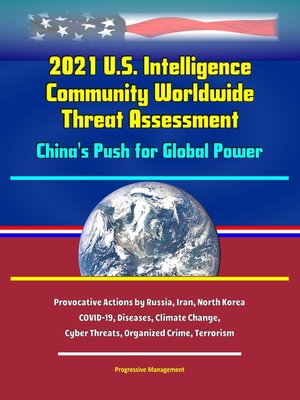2021 U.S. Intelligence Community Worldwide Threat Assessment
ebook ∣ China's Push for Global Power; Provocative Actions by Russia, Iran, North Korea; COVID-19, Diseases, Climate Change, Cyber Threats, Organized Crime, Terrorism
By Progressive Management

Sign up to save your library
With an OverDrive account, you can save your favorite libraries for at-a-glance information about availability. Find out more about OverDrive accounts.
Find this title in Libby, the library reading app by OverDrive.



Search for a digital library with this title
Title found at these libraries:
| Library Name | Distance |
|---|---|
| Loading... |
Professionally converted for accurate flowing-text e-book format reproduction, this is a reproduction of the 2021 U.S. Intelligence Community Worldwide Threat Assessment, presented before the Senate Select Committee on Intelligence, April 14, 2021. In addition to the 2021 assessment, this compilation includes the 2019, 2018 and 2017 worldwide threat assessments for comparison and historical reference. (Note that there was no assessment issued in 2020, apparently because intelligence agencies wanted to avoid conflict with the Trump administration.)
Director Director Avril Haines, Office of the Director of National Intelligence (ODNI), opened with these remarks:
During the past year, the COVID-19 Pandemic demonstrated the inherent risks of high levels of interdependence and in coming years, as reflected in our recently issued Global Trends Report, we assess that the world will face more intense and cascading global challenges ranging from disease to climate change, to disruptions from new technologies and financial crises. As we note in that report "[t]hese challenges will repeatedly test the resilience and adaptability of communities, states, and the international system, often exceeding the capacity of existing systems and models. This looming disequilibrium between existing and future challenges and the ability of institutions and systems to respond is likely to grow and produce greater contestation at every level."
For the Intelligence community, this insight compels us to broaden our definition of national security, develop and integrate new and emerging expertise into our work, deepen and strengthen our partnerships, and learn to focus on the long-term strategic threats while simultaneously addressing urgent crises. In short, at no point has it been more important to invest in our norms and institutions, our workforce, and the integration of our work. Doing so, provides us with the opportunity to meet the challenges we face, to pull together as a society, and to promote resilience and innovation.
And as we evolve, you will see our efforts to more effectively integrate longer-term destabilizing trends into our daily work, thereby promoting strategic foresight and a deeper understanding of the threats we face, which we hope will help the policy community effectively prioritize their work to address the issues we seek to present.
Against this backdrop, the Annual Threat Assessment describes an array of threats we are facing in the coming year, beginning with those emanating from key state actors. Given that China is an unparalleled priority for the Intelligence Community, I will start with highlighting certain aspects of the threat from Beijing.







